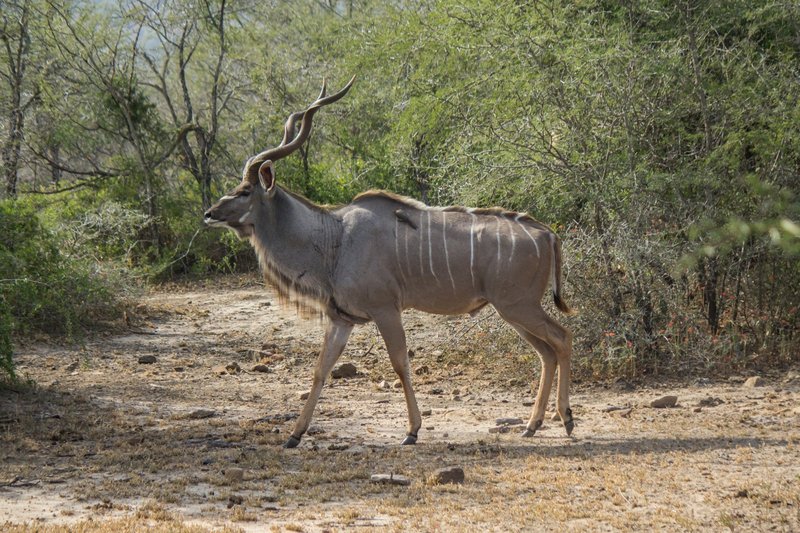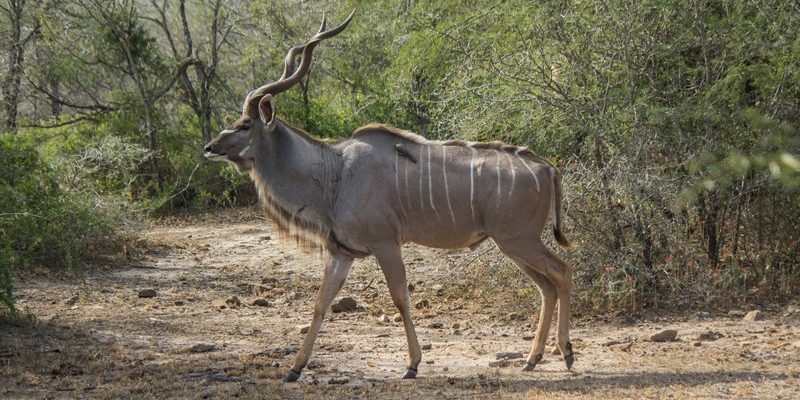
The greater kudu, scientifically known as *Tragelaphus strepsiceros*, stands out with its tall stature, striking stripes, and those long, twisting horns that can grow up to 6 feet long in males. These majestic animals are more than just a pretty face; they help shape the ecosystem around them. Let’s dive into their role and why they’re so important for the health of their environment.
What Are Greater Kudus?
Greater kudus are large antelopes native to eastern and southern Africa. They thrive in a variety of habitats, from open savannas to dense woodlands. Males are typically larger than females, weighing between 400 to 600 pounds, while females usually tip the scales at around 300 to 400 pounds. Their distinctive coloration—grayish-brown with white stripes and markings—helps them blend into their surroundings, acting as natural camouflage against predators.
These animals are browsers, meaning they primarily eat leaves, shoots, and fruits from trees and shrubs. This diet not only sustains them but also influences the growth of plant communities. By selectively feeding on certain plants, kudus help maintain a balance in the ecosystem, preventing any one species from dominating the landscape.
You might be wondering how they manage to survive in the wild despite being prey for larger predators like lions and leopards. Their height gives them an advantage as they can reach high branches that other animals can’t. Plus, their incredible agility allows them to move quickly through dense vegetation when danger approaches.
The Greater Kudu’s Impact on Plant Life
The role of the greater kudu extends far beyond their immediate survival. By browsing on various plants, they play a crucial part in shaping the vegetation of their habitat. This selective feeding helps promote growth in certain tree species while controlling underbrush, which can become overly dense if left unchecked.
Here’s the thing: this grazing behavior encourages biodiversity. As kudus munch away on certain leaves and shoots, they create openings in the foliage. These openings allow sunlight to reach the ground, enabling other plants and flowers to flourish. More plant variety means more food sources for other herbivores, which in turn supports a diverse array of animal life.
Moreover, the feces of greater kudus acts as a natural fertilizer, returning vital nutrients to the soil. This process enriches the land, allowing grasses and other plants to grow healthier and stronger. So, the next time you see a kudu, think of them as a gardener of the wild, nurturing the land they roam.
Supporting Other Wildlife
Greater kudus are not only important for the plants but also serve as a food source for various predators. As they navigate their habitat, they provide sustenance for carnivores like lions and hyenas. This natural predator-prey relationship is a fundamental aspect of maintaining the ecological balance.
Predators rely on healthy populations of prey to thrive, and kudus are significant in this food web. Healthy kudu populations support larger predator numbers, which in turn control herbivore numbers like zebras and wildebeests. It’s a full circle of life that underscores the interconnectedness of species within the ecosystem.
In addition, greater kudus play a role in seed dispersal. When they eat fruits, they inadvertently help spread the seeds of the plants they consume. This movement can lead to the growth of new plants in different areas, further contributing to the diversity and richness of their environment.
Adaptations of the Greater Kudu
The greater kudu has developed some incredible adaptations that help them thrive in their habitat. Their long legs allow for swift movement and agility, making it easier to escape predators. They can leap up to 6 feet high and cover distances of 30 feet in a single bound, which is quite impressive for a creature of their size!
Another fascinating adaptation is their acute sense of hearing and smell. These heightened senses help them detect danger long before it becomes a threat. Kudus often stand still, using their keen senses to scan the environment for any signs of predators. This cautious behavior is another reason they’ve managed to survive in the wild for so long.
Additionally, their unique spiral horns serve multiple purposes. Apart from being a mating signal during the rut, they can also be used in defending against predators. So, while they’re undeniably beautiful, those horns are functional too.
Conservation Status and Threats
Despite their impressive adaptations and ecological importance, greater kudus face several threats. Habitat loss due to human development, agriculture, and poaching are significant challenges for their populations. As their natural environment shrinks, so does their food supply and space for roaming.
Efforts to conserve greater kudu populations are crucial. Various wildlife reserves and conservation programs are working to protect their natural habitats while promoting education about these magnificent animals. By raising awareness and supporting conservation efforts, we can help ensure that greater kudus continue to thrive in the wild.
You might also be surprised to learn that community-based conservation initiatives involve local people in protecting these animals. By providing education and alternative livelihoods, communities see the value in preserving the greater kudu, which benefits both wildlife and humans.
The Greater Kudu as a Cultural Symbol
In many African cultures, the greater kudu holds significant symbolic meaning. They are often admired for their grace and beauty, and this admiration translates into their representation in art, folklore, and even spirituality. Stories and songs celebrating the kudu can be found throughout various communities, underscoring their cultural importance.
This symbolism can also foster a sense of pride and responsibility towards conservation efforts. When people see greater kudus as part of their cultural identity, they may be more motivated to protect them and their habitats. Animals like the kudu can inspire conservation messaging that resonates at a deeper level with communities.
The connection between greater kudus and people is a beautiful reminder of how intertwined our lives are with wildlife. When we take the time to understand their role in the ecosystem, it becomes clear that they deserve our attention and protection.
So, what’s the takeaway here about the greater kudu’s role in its ecosystem? These graceful creatures are much more than just stunning animals. They play a vital role in maintaining plant diversity, supporting other wildlife, and contributing to the health of their ecosystems.
By understanding their importance, we can better appreciate the interconnectedness of all living things. Greater kudus remind us that every species has its place and purpose. Protecting them means protecting a delicate balance that supports countless other lives, including our own.
The next time you think about the rich tapestry of life in Africa, remember the humble greater kudu. They truly embody the spirit of the wild, contributing to the vibrant ecosystems that continue to inspire and amaze us.

